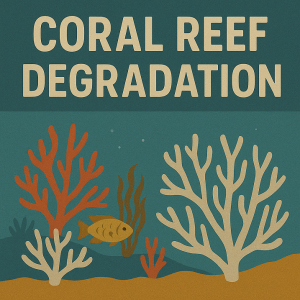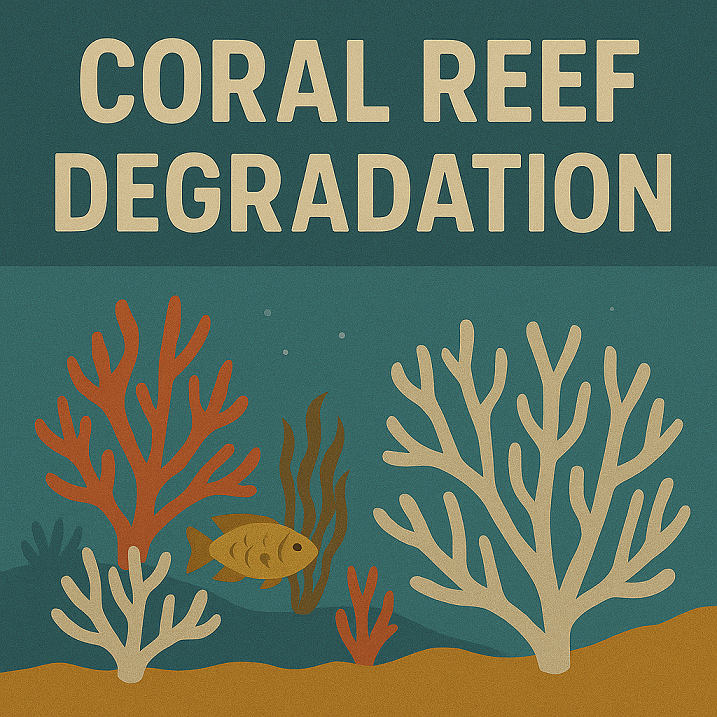Explore the causes, real-world impacts, and science-backed solutions to coral reef degradation in the South China Sea. A deep dive into one of the region’s most urgent maritime environmental challenges.

Why Coral Reef Health Matters in the South China Sea
Stretching across a geopolitically complex and ecologically vibrant area, the South China Sea (SCS) is home to some of the world’s most biologically diverse coral reef systems. From Vietnam’s coastal shallows to the Spratly and Paracel Islands, these reefs support over 3,000 marine species and serve as critical breeding, feeding, and nursery grounds. Yet, over the past few decades, the region has witnessed accelerated coral degradation.
This decline is not just an environmental issue—it’s a maritime crisis. Coral reefs contribute to fisheries, tourism, shoreline protection, and even pharmaceutical research. According to the United Nations Environment Programme (UNEP), the economic value of coral reefs in Southeast Asia is estimated to exceed USD $12 billion annually. Their loss could destabilize coastal communities, fisheries, and marine biodiversity on a scale that goes beyond borders.
Primary Drivers of Coral Reef Degradation in the South China Sea
Climate Change and Ocean Warming
Global climate change remains the most far-reaching driver of coral reef degradation in the SCS. Rising sea surface temperatures, exacerbated by El Niño events, trigger coral bleaching. According to the Intergovernmental Panel on Climate Change (IPCC), coral reefs may decline by 70-90% if global warming reaches 1.5°C above pre-industrial levels. The 2016 mass bleaching event, which affected reefs in the Spratly Islands, is a stark warning of this trend.
Warmer waters also promote the growth of pathogens and disrupt symbiotic relationships between coral and zooxanthellae (photosynthetic algae), weakening reef resilience.
Ocean Acidification
Ocean acidification, driven by the absorption of atmospheric CO2, impairs coral calcification. The Global Ocean Acidification Observing Network (GOA-ON) has reported measurable declines in aragonite saturation in Southeast Asian waters. With lower saturation, coral skeletons become brittle and more vulnerable to erosion and bioerosion by organisms like parrotfish and boring sponges.
Overfishing and Destructive Fishing Practices
Illegal, unreported, and unregulated (IUU) fishing in the South China Sea undermines reef ecosystems. Methods such as blast fishing (using explosives) and cyanide fishing (to stun fish for live trade) cause immediate physical destruction. The World Wildlife Fund (WWF) estimates that blast fishing can destroy an area of reef in a single explosion, leaving it uninhabitable for decades.
Moreover, overfishing disrupts ecological balance, removing key herbivores like parrotfish that help control algal growth on reefs.
Coastal Development and Land Reclamation
Several countries bordering the SCS have pursued aggressive land reclamation for military, tourism, and commercial purposes. Satellite imagery analyzed by the Asia Maritime Transparency Initiative (AMTI) reveals extensive reef destruction in the Spratly Islands due to dredging and artificial island-building activities. These projects not only smother coral with sediment but also alter water circulation, temperature, and light penetration.
Marine Pollution and Sedimentation
Runoff from agriculture, untreated sewage, oil spills, and plastic debris from surrounding nations severely stress coral systems. According to a 2022 report by the Journal of Marine Pollution Bulletin, nutrient-rich runoff encourages algal blooms that outcompete coral. Meanwhile, microplastics have been found embedded in coral tissues, hindering their growth and reproductive ability.
Scientific and Policy-Based Solutions: Can We Still Save the Reefs?
Marine Protected Areas (MPAs) and Enforcement
The establishment of MPAs has shown promise in protecting coral ecosystems when coupled with adequate enforcement. The Coral Triangle Initiative (CTI), which includes Indonesia, Malaysia, and the Philippines, has designated parts of the SCS under ecological conservation zones. Yet, these MPAs often face enforcement challenges due to overlapping territorial claims.
A regional agreement, perhaps modeled after the Antarctic Treaty, could be an avenue for depoliticizing marine protection and improving multinational cooperation.
Coral Restoration Technologies
Recent years have seen advancements in coral rehabilitation, including:
- Microfragmentation and coral gardening: Techniques pioneered by institutions like the Mote Marine Laboratory allow rapid propagation of heat-tolerant coral strains.
- Biorock technology: Electrically charged structures stimulate coral calcification and improve survival rates, tested successfully in parts of Indonesia and Thailand.
- 3D-printed artificial reefs: Mimic natural reef structures and offer immediate habitat for marine species while corals regrow.
Although these are not silver bullets, they offer scalable tools when integrated with broader conservation strategies.
Regional Environmental Governance
The South China Sea lacks a unified environmental governance framework. ASEAN has promoted dialogue through initiatives like the “ASEAN Working Group on Coastal and Marine Environment,” but enforcement remains fragmented.
A legally binding regional protocol, similar to the Barcelona Convention for the Mediterranean, could help standardize pollution control, biodiversity monitoring, and environmental impact assessments across borders.
Pollution Control and Waste Management
Tackling land-based pollution is vital. Countries like Vietnam and the Philippines have piloted community-based wastewater treatment and coastal plastic cleanups. Investment in green infrastructure and stricter industrial discharge regulation could help reduce nutrient and sediment inflow to coral habitats.
According to a 2023 UNEP study, improved wastewater management could reduce coral exposure to nutrients by up to 70% in densely populated coastal areas.
Satellite Monitoring and Citizen Science
Tools like Global Coral Reef Monitoring Network (GCRMN) and NASA’s CORAL mission provide real-time data on reef health, temperature anomalies, and algal cover. Pairing this with citizen science initiatives (e.g., Reef Check Malaysia) empowers local stakeholders and adds layers of ground-truthing.
Real-World Case Studies in the South China Sea
The Spratly Islands: From Coral Haven to Construction Zone
Once home to thriving coral gardens, parts of the Spratly Islands have been transformed into artificial landmasses with military outposts. A 2019 study by the University of Hong Kong found that more than 160 km² of reef had been damaged or destroyed in the past decade due to dredging and construction. Satellite heat maps reveal higher sediment plumes and reduced reef biomass in areas adjacent to these activities.
Danajon Bank, Philippines: Community-Led Reef Revival
Danajon Bank is the only documented double barrier reef in the Philippines, and a rare feature globally. After years of decline from overfishing and pollution, local fishermen collaborated with NGOs and the Philippine Department of Environment and Natural Resources to establish no-take zones and coral nurseries.
Today, fish biomass and coral cover have significantly increased, becoming a model for grassroots reef management.
Nha Trang Bay, Vietnam: Tourism and Resilience
Vietnam’s Nha Trang Bay has faced challenges from tourism-driven pollution and unregulated diving. But through stricter zoning, mandatory environmental briefings for divers, and coral monitoring by local universities, the reef’s resilience has shown signs of recovery.
FAQ: Coral Reef Degradation in the South China Sea
Why are coral reefs important for maritime industries?
Coral reefs support fisheries, tourism, coastal protection, and maritime biodiversity. Their degradation can harm economic livelihoods, especially in coastal communities.
How does climate change affect reefs in the South China Sea?
Through warming waters, ocean acidification, and sea-level rise, climate change causes coral bleaching, structural weakening, and habitat loss.
What countries are most involved in reef degradation in the SCS?
China, Vietnam, the Philippines, and Malaysia have all contributed to reef stress through fishing, reclamation, or pollution, though the levels and forms vary.
Can damaged reefs recover naturally?
Recovery is possible but slow. It requires reduced stressors, such as pollution and overfishing, and often human intervention through restoration techniques.
Is there any international law protecting reefs in the South China Sea?
The United Nations Convention on the Law of the Sea (UNCLOS) mandates marine environmental protection, but enforcement is weak due to overlapping territorial claims.
What can individuals do to help?
Reduce plastic use, support sustainable seafood, donate to marine conservation, and spread awareness through education and responsible tourism.
Conclusion: Navigating a Shared Responsibility
Coral reef degradation in the South China Sea is a multi-layered crisis—environmental, economic, and geopolitical. While the causes are complex and often transboundary, so too must be the solutions. Climate resilience, regional cooperation, and community empowerment are not just lofty ideals, but necessary steps.
From pioneering technologies in coral restoration to the establishment of marine protected areas, hope is not lost. But time is short. As maritime professionals, policymakers, educators, and everyday ocean lovers, our actions today will determine whether the reefs of the South China Sea remain resilient guardians of marine life or become yet another casualty of human shortsightedness.
References
- Intergovernmental Panel on Climate Change (IPCC). (2023). Sixth Assessment Report. https://www.ipcc.ch/report/ar6/
- UNEP. (2023). Coral Reefs: Ecosystem Services and Threats. https://www.unep.org/resources/coral-reefs
- WWF. (2022). Destructive Fishing Practices. https://www.worldwildlife.org/
- Asia Maritime Transparency Initiative (AMTI). (2022). Island Tracker. https://amti.csis.org/
- Marine Pollution Bulletin. (2022). “Microplastics and Coral Health in Southeast Asia.”
- Coral Triangle Initiative (CTI-CFF). https://www.coraltriangleinitiative.org
- Reef Check Malaysia. https://www.reefcheck.org.my
- GCRMN. (Global Coral Reef Monitoring Network). https://gcrmn.net
- NASA CORAL Mission. https://coral.jpl.nasa.gov/
- Journal of Marine Science and Engineering (JMSE). https://www.mdpi.com/journal/jmse
- University of Hong Kong. (2019). SCS Coral Impact Report.
- Philippine Department of Environment and Natural Resources (DENR). https://www.denr.gov.ph/

